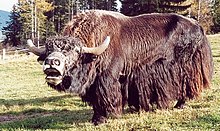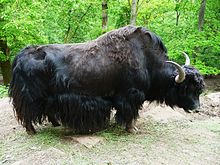Wild yak
![]()
The title of this article is ambiguous. For other meanings, see YAK.
The yak or yak (Bos mutus), also spelled yak, is a species of cattle common in High Asia. It is one of the five cattle species that have been domesticated (see domestic cattle). By a decision of the ICZN, since 2003 the younger species name mutus (Latin for "dumb"), based on a specimen of the wild yak, has taken precedence over grunniens ("grunting"), based on the domestic form.
Because of its grunt-like sounds, the yak is also called (Tibetan) grunt ox. The name "yak" comes from the Tibetan language. In Tibetan, however, only the male animal is called གཡག་ g.yag (pronunciation: [jáʔ]), while the female animal is called འབྲི 'bri (pronunciation: [ɖì]).
While the domestic yak is widespread in large numbers in the Himalayas, Mongolia and even southern Siberia, the wild yak is threatened with extinction. Because of its adaptation to the extreme climatic conditions of its habitat, the yak continues to provide the livelihood of a large proportion of the people living in the Central Asian highlands and neighbouring countries. It provides milk, meat, leather, hair and wool. Its dung serves as fuel. The yak is still used as a beast of burden and mount. In an area of more than 1.4 million square kilometres, rural ways of life are predominantly only possible through yaks.
Features
Physique
A yak bull can reach a head-torso length of 3.25 meters, a height at the withers of 200 centimeters and a weight of over one ton. The cows are much smaller and lighter. They reach a maximum withers height of 150 centimeters and weigh between 400 and 500 kilograms. Compared to a domestic cattle, the body of the yak is relatively long. Unlike domestic cattle, which have 13 pairs of ribs, the yak has 14 or 15 pairs of ribs. As a result, the rib cage is broad and deep, which provides sufficient space for the strongly developed lungs and heart. The well-developed rib cage gives the yak a compact appearance despite its relatively elongated build.
Due to the elongated spinous processes of the cervical and thoracic vertebrae, the yak has a hump. This is somewhat more pronounced in males. The neck of males is also more muscular. The back line is slightly sloping in both sexes. This makes the hindquarters more flexible, which contributes to the yak's surefootedness.
In adaptation to the climate, the yak's flot mouth is very small. In particular, the upper lip is very mobile, so that yaks can use much worse pastures with lower vegetation than cattle. The horns originate on the sides of the head and lead upward in an even curve. They grow up to one meter in length. The udder of the cows, which has two pairs of teats, is very small and set high. The teats are only two to three inches long. The scrotum of the bulls is also close to the lower abdomen and is much smaller than that of a domestic cattle.
Fur
The coat color of the wild yak varies from dark brown to black. The back as well as the flot mouth are usually somewhat lightened. The yak is the only cattle species that has a multi-layered coat. A distinction is made between a firmer top coat or long coat, a coarser wool and a fine, spinnable undercoat or fine wool.
Except for the fledgling mouth and the teats embedded in the hair, all parts of the body are covered with dense hair. The foreskin of the penis is also covered with hair for protection against the cold. While the lower abdomen, the udder and the scrotum are only covered with short hairs, the hairs on the lower part of the body are very long and fall down as a so-called abdominal mane like a pelmet. The Yak appears decidedly short-legged through it. The tail is longhaired from the root. The long hairs on the chest, tail and belly of the Yak are also called horsehair, because they are similar to the hairs on the tail and mane of horses. However, they are much softer than those of horses.
Coarse wool hairs with a length of five to thirteen centimeters are distributed over the entire body. As a third type of hair, fine wool is found in all body regions and makes up over 80 percent of the hair. In the abdominal region, for example, yaks have 220 coarse hairs and 800 fine wool hairs per square centimetre. During the shedding process, the yak loses mainly the woolly hair. The loss begins at the neck and continues at the back and belly region.
Locomotion
The Yak hooves are relatively small and compact. They have sharp hoof tips and hard hoof edges. Due to their small hooves, they sink relatively deep into the ground, which helps them to slow down their forward momentum when moving downhill. They are basically very sure-footed when moving slowly and will cross swampy areas safely. If they sink too much in wet ground, they spread their legs and use the underside of their body to avoid sinking deeper. They then move on with swimming-like movements and thus show a different behaviour than, for example, horses, which in a comparable situation lash out in panic.
Basically, yaks are very agile. Grazing yaks always take breaks in which they playfully chase each other with their tails raised. Their galloping movements resemble those of horses. A sudden danger can lead to panic-like flight in yak herds. If their flight leads them downhill, there are occasional deaths from falls.

Yak Bull

House-yak-bull, that shows many characteristics of the Wildyaks in the appearance.

House Yak Bull
Physiology
Adaptation to heat and cold
Yaks vary their respiratory rate depending, among other things, on the outside temperature. At high temperatures, respiration and pulse are high in order to dissipate excess heat, and they can then be three to four times as high as in cattle. Even at ambient temperatures above 13 degrees, respiratory rates increase. Above an ambient temperature of 16 degrees, heart rate and body temperature increase. When the ambient temperature reaches 20 degrees, yaks stay near water or in the shade. As a rule, they no longer eat, drink or ruminate and remain motionless in one place.
At low outside temperatures, the breathing rate of yaks drops to seven to fifteen breaths per minute. As a result, heat loss is relatively low. They can tolerate ambient temperatures of -30 °C to -40 °C without any problems. Sweat glands are found distributed over the entire body, but their functionality is considerably limited. In various tests, sweat secretion could only be found in the area of the muzzle. This characteristic also contributes to the increase in cold tolerance.
Adjustment to the height
The low atmospheric pressure at high altitudes is not a limitation for yaks. Due to the higher oxygen affinity of the yak hemoglobin compared to cattle, they can absorb sufficient oxygen.
Diseases and life expectancy
Yaks are susceptible to all diseases that affect other cattle species. These include anthrax, foot-and-mouth disease and tuberculosis, and once rinderpest. Yaks can reach an age of over 20 years in exceptional cases.
Search within the encyclopedia